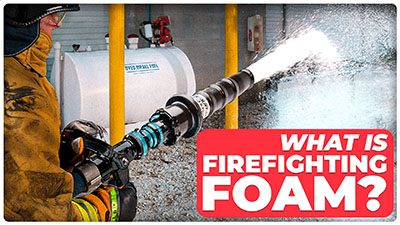What is Firefighting Foam and Why do Firefighters Use it?
Firefighting foam plays a vital role in successful firefighting. Developed over a century ago to combat challenging oil fires resistant to water, this unique firefighting tool has evolved while retaining its core purpose.Today, it is still used to knock down and secure burning and unignited flammable liquids. Class A foams are also used on ordinary combustibles to help water become more effective in fire extinguishment.
In this article we are going to explore what firefighting foam is and how it helps firefighters extinguish a fire.
What is Firefighting Foam
Class B foams used in flammable liquid firefighting are a mixture of foam concentrate, water, air, and mechanical agitation that creates a foam blanket to cover a fire. While Aqueous Film Forming Foams (AFFF) have been a staple in the fire service for years, we now know they contain chemicals that persist in the enfironment, potentially infiltrating groundwater and posing health risks to those exposed. To combat this, the fire industry is turning to Fluorine Free Foam (F3) and optimizing equipment usage to maximize the benefits of the product.
A variety of equipment can be used to apply foam to a fire hazard. Portable foam systems, foam tubes, foam eductors, self educting nozzles, and handheld or fixed and portable monitor nozzles are used to accurately mix and apply foam based on factors such as foam type, fire type, desired foam expansion rate, and more.
When firefighting foam is used on a fire, the foam blanket smothers the fire, removes oxygen, reduces heat, and creates a barrier that mitigates vapor release. In essence, foam acts as a versatile tool that tackles the components of the fire tetrahedron (oxygen, heat, fuel) from various angles, enabling more efficient fire suppression.
Why do Firefighters Use Firefighting Foam
Firefighters use foam for several reasons:
-
Overcoming the challenges of extinguishing flammable liquids with water alone is no easy feat. Foam application offers significant advantages, enabling faster extinguishment compared to water while sealing off vapor hazards.
-
Foam blankets the flammable liquid, effectively smothering it by creating a physical barrier that starves it of oxygen. Simultaneously, it extracts heat from the liquid and surrounding surfaces.
-
Flammable liquids emit vapors into the air. Firefighting foam establishes a robust vapor barrier that prevents these vapors from dispersing upwards. This ensures a safer environment for firefighters and individuals in close proximity or downwind from the fire hazard.
-
In certain cases involving ordinary combustibles, water must penetrate deeper to fully extinguish the fire and prevent rekindling. This is where Class A Foam shines. Among its features, Class A Foam reduces the surface tension of water, allowing it to penetrate more deeply into the fuel.
Firefighters rely on foam to effectively and safely extinguish fires in situations where water alone would be ineffective, problematic, or pose a hazard. As you can see, firefighting foam stands as a critical tool in the firefighting arsenal, capable of producing positive outcomes and expediting fire suppression when utilized appropriately.
